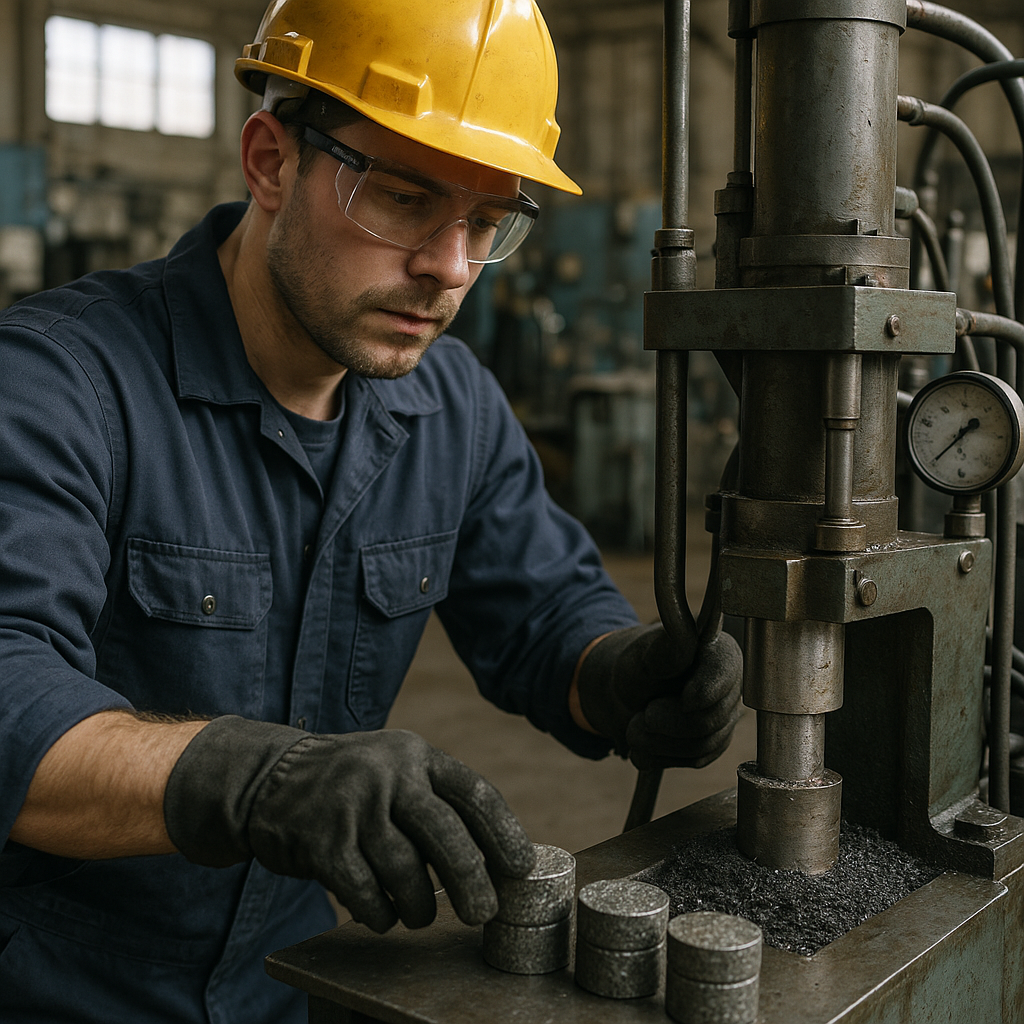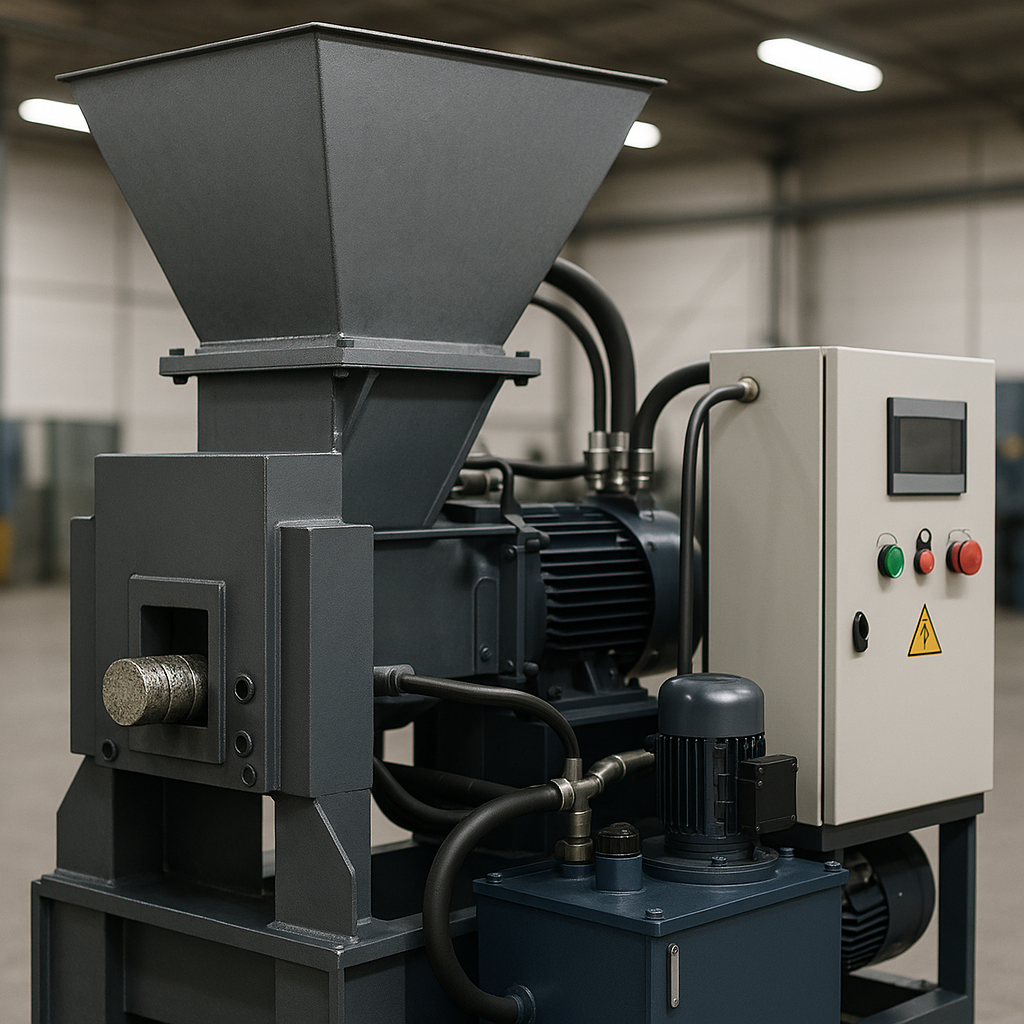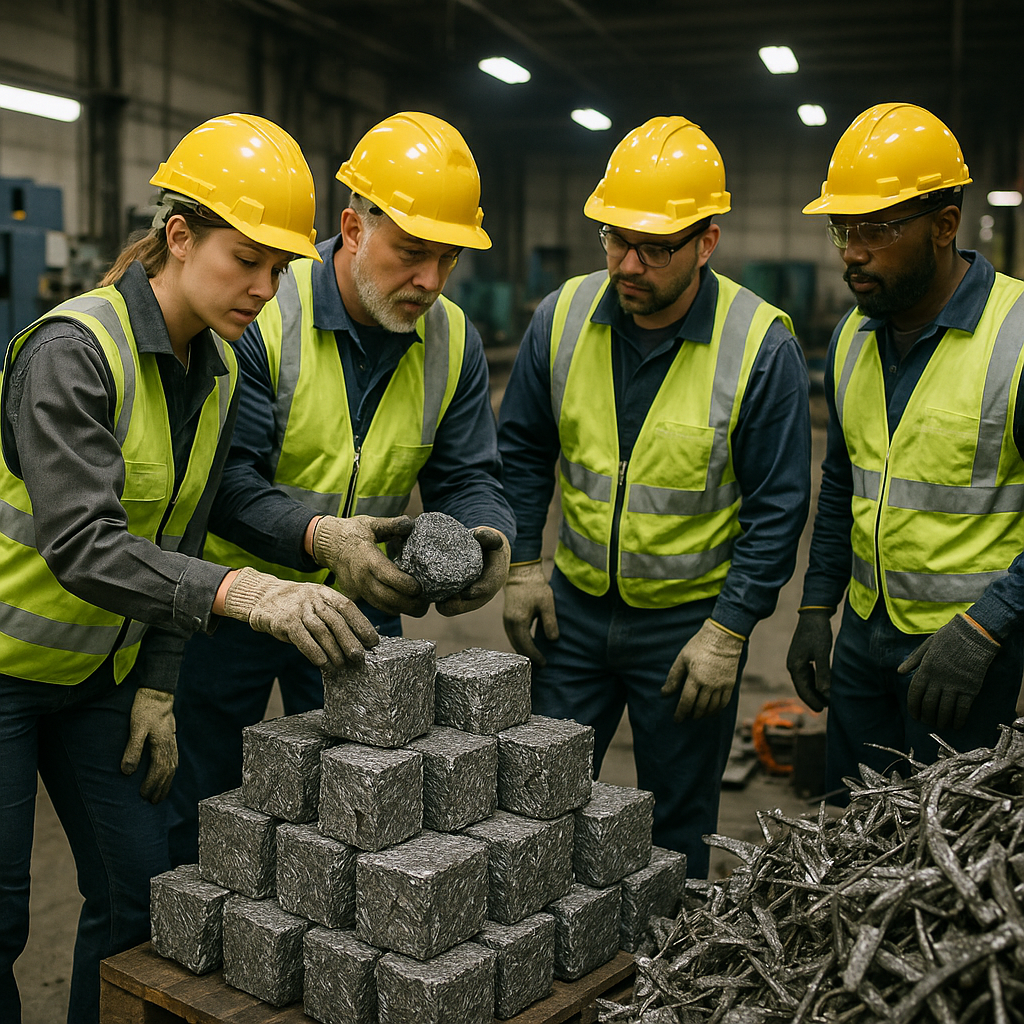5901 Botham Jean Blvd, Dallas, TX 75215
Metal Briquetting Process: How It Works, Key Components, Benefits, and Recycling Impact
October 8, 2025Metal briquetting transforms loose metal waste into valuable assets. The process compresses scrap metal, chips, shavings, and turnings into dense, uniformly-shaped blocks called briquettes. These compact forms make handling, storage, and transportation significantly more efficient.
Metal briquetting utilizes powerful hydraulic systems to apply extreme pressure to loose metal materials. These systems employ programmable logic controllers (PLCs) that precisely manage compression cycles. The technology ensures consistent quality by monitoring pressure levels and adjusting compression time based on material density variations.
Beyond waste reduction, briquetting delivers substantial benefits to metal processors and recyclers. The process increases scrap metal value, recovers expensive coolants and cutting fluids, reduces transportation costs, and frees up valuable shop floor space. Transforming metal waste into standardized briquettes is crucial in modern metal recycling operations and sustainable manufacturing practices.
How Does a Metal Briquetting Machine Work?

Metal briquetting machines transform loose metal scrap into dense, compact briquettes through a precise mechanical process. This operation follows a systematic sequence designed to maximize density while maintaining efficiency.
The process begins when metal waste materials like turnings, chips, or shavings are loaded into a feed hopper. This hopper serves as the collection and entry point for all incoming scrap material, ensuring a consistent flow into the system.
From the feed hopper, a screw conveyor transports the metal scrap to a precharger chamber. The conveyor operates on a cycle time controlled by a programmable logic controller (PLC), adjusting automatically based on the particle size and density to ensure optimal briquette quality.
Once the screw conveyor fills the precharger chamber with the appropriate amount of material, the precharger activates, performing initial compression. It pushes the loose metal into a pressing chamber, preparing it for final compression.
The main press piston then engages, applying substantial force to the material in the pressing chamber, forming it into a dense briquette. This high-pressure compression binds the metal particles without requiring additional binding agents.
Pressure sensors continuously monitor compression levels to maintain pressure until reaching a predetermined value, ensuring briquette density meets specific requirements for handling, transport, and recycling.
During compression, residual coolants or oils are squeezed out from the scrap and collected in a sump beneath the machine for potential reuse.
After compression, the pressing mold repositions to align the finished briquette with an ejection opening. Ejectors push the briquette out through holes in the front plate of the machine. Meanwhile, the main compression piston and precharger return to their starting positions, and the empty die realigns with the compression piston to begin a new cycle.
This continuous process repeats until all material in the feed hopper is processed. Modern metal briquetting machines can produce briquettes with densities up to five times greater than the original loose scrap, significantly reducing volume while creating a product that is easier to handle, transport, and recycle.
Various types of metal briquetting machines exist, with hydraulic systems being particularly effective for metal compression due to their ability to maintain high pressure for longer periods. This extended compression time allows more elastic deformation to transform into permanent plastic deformation, resulting in stronger, more stable briquettes.
| Material | Compression Pressure (kg/mm²) |
| Steel | 10 – 16 |
| Aluminium | 7 – 10 |
| Booster Pressure for Steel | 16 |
| Booster Pressure for Aluminium | 10 |
What Are the Key Components of a Metal Briquetting System?

Metal briquetting systems convert loose metal shavings into dense, valuable blocks through a sophisticated compression process. These systems rely on several critical components working in harmony to ensure efficient operation. Let’s examine the key elements that make up a metal briquetting system.
Hydraulic Power System
The hydraulic power system is the core of any briquetting operation. A motor-driven hydraulic pump generates the substantial pressure needed to compress metal shavings. This pressure is then directed through the control block, which regulates the flow and pressure of hydraulic oil.
Hydraulic hoses connect the control block to various cylinders that perform the compression work. The system includes a hydraulic oil tank that stores the oil, filters that remove contaminants, and an oil cooler that maintains optimal operating temperatures.
Material Handling Components
The process begins with the feed hopper, which collects loose metal shavings and directs them toward the processing area. A screw conveyor inside the hopper moves material at a controlled rate toward the precharger chamber.
The precharger compresses the material initially before it enters the main pressing chamber. This preliminary compression helps create more consistent briquettes and improves the efficiency of the main compression cycle.
Compression System
The heart of the briquetting process lies in the compression system. The main press piston applies tremendous force to compact metal shavings into dense briquettes. Most systems feature a pressing chamber or mold that shapes the briquette during compression.
Advanced briquetting systems include pressure monitoring to ensure briquettes reach a predetermined density, maintaining consistent quality across production runs.
Ejection and Control Systems
After compression, ejectors positioned on either side of the main press piston push finished briquettes out through ejector holes in the front plate. This controlled ejection process ensures briquettes exit the machine without damage.
A Programmable Logic Controller (PLC) orchestrates the entire operation, adjusting parameters like screw conveyor timing based on material density and particle size. This intelligent control ensures optimal performance even with varying materials.
Fluid Recovery System
An often overlooked but valuable component is the fluid recovery system. As compression occurs, cutting fluids and coolants are squeezed from the metal shavings. These fluids collect in a sump beneath the machine and can be pumped out for filtration and reuse, providing significant cost savings.
| Hydraulic Power System | Generates and regulates pressure using a motor-driven hydraulic pump, control block, hoses, tanks, filters, and oil cooler. |
| Material Handling Components | Includes feed hopper and screw conveyor to move metal shavings to precharger chamber for initial compression. |
| Compression System | Main press piston and pressing chamber or mold compress metal shavings into dense briquettes. |
| Ejection and Control Systems | Ejectors push briquettes from the machine, controlled by a PLC to adjust processes based on material variations. |
| Fluid Recovery System | Collects and reuses coolants and fluids squeezed from metal shavings during compression. |
Each component in a metal briquetting system plays a vital role in transforming waste metal shavings into valuable, dense briquettes. The integration of hydraulic power, precise material handling, and intelligent control systems ensures efficient operation and high-quality output.
Conclusion: The Impact of Metal Briquetting on Metal Processing

The economic advantages of metal briquetting are substantial. By reducing waste volume by up to 90%, facilities notably save on storage space and transportation costs. The increased density of briquettes fetches better prices in the recycling market compared to loose metal chips, turning previous waste into a valuable commodity. Additionally, the briquetting process extracts oils and coolants from metal waste, allowing for their recovery and reuse in production.
The environmental benefits are equally crucial for metal processing operations. Briquetting supports the circular economy model by facilitating efficient metal recycling, reducing the need for virgin raw materials. This decreases energy consumption, lowers carbon emissions, and minimizes environmental impact throughout the supply chain. As sustainability becomes more critical for regulatory compliance and corporate responsibility, metal briquetting offers a viable solution for meeting these demands.
Looking ahead, metal briquetting technology is poised to play a more crucial role in sustainable manufacturing. Advancements in automation, increased energy efficiency, and integration with other waste management systems will further enhance the value of this technology. The metal processing industry is evolving, and metal briquetting is at the forefront of this change. For your recycling needs and to learn more about implementing metal briquetting in your operations, contact Okon Recycling at 214-717-4083.
